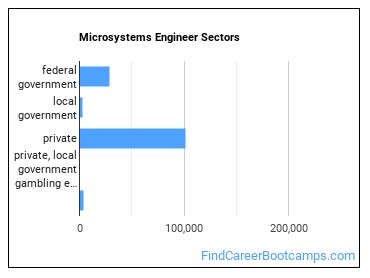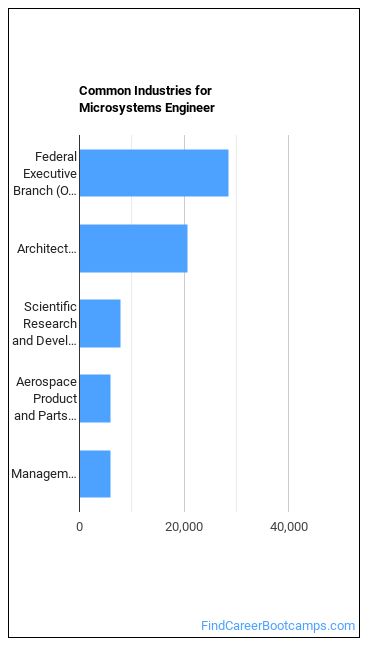Life As a Microsystems Engineer
Microsystems Engineer Job Description Research, design, develop, or test microelectromechanical systems (MEMS) devices.
Microsystems Engineer Responsibilities
- Propose product designs involving microelectromechanical systems (MEMS) technology, considering market data or customer requirements.
- Develop or validate product-specific test protocols, acceptance thresholds, or inspection tools for quality control testing or performance measurement.
- Conduct experimental or virtual studies to investigate characteristics and processing principles of potential microelectromechanical systems (MEMS) technology.
- Create or maintain formal engineering documents, such as schematics, bills of materials, components or materials specifications, or packaging requirements.
- Design sensors or switches that require little or no power to operate for environmental monitoring or industrial metering applications.
- Conduct acceptance tests, vendor-qualification protocols, surveys, audits, corrective-action reviews, or performance monitoring of incoming materials or components to ensure conformance to specifications.
What Every Microsystems Engineer Should Know
These are the skills Microsystems Engineers say are the most useful in their careers:
Critical Thinking: Using logic and reasoning to identify the strengths and weaknesses of alternative solutions, conclusions or approaches to problems.
Active Listening: Giving full attention to what other people are saying, taking time to understand the points being made, asking questions as appropriate, and not interrupting at inappropriate times.
Reading Comprehension: Understanding written sentences and paragraphs in work related documents.
Complex Problem Solving: Identifying complex problems and reviewing related information to develop and evaluate options and implement solutions.
Writing: Communicating effectively in writing as appropriate for the needs of the audience.
Systems Analysis: Determining how a system should work and how changes in conditions, operations, and the environment will affect outcomes.
Types of Microsystems Engineer
- Systems Engineer
- Nanotechnologist
- MEMS Engineer (Microelectromechanical Systems Engineer)
- Product Design Engineer
- MEMS Integration Engineer (Microelectrical Mechanical Integration Engineer)
Job Outlook for Microsystems Engineers
In 2016, there was an estimated number of 132,500 jobs in the United States for Microsystems Engineer. New jobs are being produced at a rate of 6.4% which is above the national average. The Bureau of Labor Statistics predicts 8,500 new jobs for Microsystems Engineer by 2026. There will be an estimated 9,500 positions for Microsystems Engineer per year.

The states with the most job growth for Microsystems Engineer are Nevada, Utah, and North Dakota. Watch out if you plan on working in Alaska, Minnesota, or Vermont. These states have the worst job growth for this type of profession.
Do Microsystems Engineers Make A Lot Of Money?
The typical yearly salary for Microsystems Engineers is somewhere between $50,750 and $155,650.

Microsystems Engineers who work in District of Columbia, Maryland, or Virginia, make the highest salaries.
How much do Microsystems Engineers make in each U.S. state?
| State | Annual Mean Salary |
|---|---|
| Alabama | $115,710 |
| Alaska | $114,040 |
| Arizona | $94,450 |
| Arkansas | $71,510 |
| California | $107,700 |
| Colorado | $111,610 |
| Connecticut | $100,230 |
| District of Columbia | $132,530 |
| Florida | $82,970 |
| Georgia | $93,580 |
| Hawaii | $96,940 |
| Idaho | $110,270 |
| Illinois | $87,220 |
| Indiana | $73,340 |
| Iowa | $78,230 |
| Kansas | $82,060 |
| Kentucky | $79,690 |
| Louisiana | $90,580 |
| Maine | $85,800 |
| Maryland | $118,420 |
| Massachusetts | $109,220 |
| Michigan | $90,420 |
| Minnesota | $101,620 |
| Mississippi | $79,630 |
| Missouri | $86,850 |
| Montana | $79,590 |
| Nebraska | $82,760 |
| Nevada | $94,950 |
| New Hampshire | $99,070 |
| New Jersey | $114,990 |
| New Mexico | $114,790 |
| New York | $95,270 |
| North Carolina | $83,900 |
| North Dakota | $83,270 |
| Ohio | $93,370 |
| Oklahoma | $83,080 |
| Oregon | $90,720 |
| Pennsylvania | $96,550 |
| Rhode Island | $95,790 |
| South Carolina | $100,750 |
| South Dakota | $84,320 |
| Tennessee | $82,030 |
| Texas | $113,370 |
| Utah | $89,810 |
| Vermont | $81,960 |
| Virginia | $118,390 |
| Washington | $104,890 |
| West Virginia | $91,420 |
| Wisconsin | $86,600 |
| Wyoming | $97,040 |
What Tools & Technology do Microsystems Engineers Use?
Although they’re not necessarily needed for all jobs, the following technologies are used by many Microsystems Engineers:
- Microsoft Excel
- Microsoft Word
- Microsoft Office
- Web browser software
- Python
- Microsoft Access
- Microsoft Windows
- Autodesk AutoCAD
- Adobe Systems Adobe Photoshop
- The MathWorks MATLAB
- Linux
- Microsoft Visual Basic
- UNIX
- Computer aided design CAD software
- National Instruments LabVIEW
- C
- Dassault Systemes SolidWorks
- PTC Creo Parametric
- Apple macOS
- Simulation software
Becoming a Microsystems Engineer
What kind of Microsystems Engineer requirements are there?

How Long Does it Take to Become a Microsystems Engineer?

Where Microsystems Engineers Are Employed

The table below shows some of the most common industries where those employed in this career field work.

References:
Image Credit: Airman 1st Class Aaron Jenne via Public domain
More about our data sources and methodologies.
